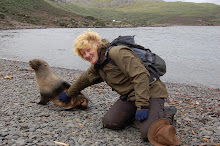
Having arrived on Bird Island on November 4th 2007, I have now been here a full year - not quite halfway through my time South, but then again I don't want to make it sound like I am longing to come home. In fact, quite the opposite. I feel quite at home here on our little rock in the Southern Ocean. It has been fascinating to see the island go 'full-circle'. Last November I arrived at the same time as the first bull fur seals, and seeing their return to the beaches in the last few days has brought to completion a fascinating years cycle.
 Adult male Antarctic fur seal beside the fuel drums
Adult male Antarctic fur seal beside the fuel drums
Over the next few weeks, as the short summer peaks and then fades at these southern latitudes, we shall witness once again the explosion of life that makes Bird Island so special - the first eggs have already been laid around the island (northern giant petrels, gentoo penguins, grey-headed albatrosses and the tiny South Georgia pipits are the first breeders) and soon these will be hatching. The first fur seal pups are expected from the middle of November, making the beaches inaccessible except to the bravest of folk.

 Some juvenile fur seals play-fight at the shore
Some juvenile fur seals play-fight at the shoreIt will be a few weeks yet before the wandering albatrosses return to their nest sites, two years since they last bred, to begin another year-long task of raising a single chick, which will hopefully help halt the decline in numbers of wanderers, that have been so badly hit by irresponsible fishing practices. This years chicks are starting to look more like birds, after waiting on their nests throughout the winter, insulated by a thick coat of down that they are now shedding, making way for feathers. By Christmas, most will have fledged.
After our quiet winter with only four on base from mid-April until mid-September, our numbers swelled, first to six, then to eight, before dropping back to six again with the departure of the BBC crew. It is always nice to see new faces, which always bring a new dynamic to life on the island. The arrival of the BAS ship on November 22nd will bring numbers on base back up again, including the arrival of two of next years wintering team, who we are keen to meet! Derren and I by that stage will be the 'old hands' on BI, as Fabrice will have departed.
 An adult male fur seal guards the main door into the base
An adult male fur seal guards the main door into the baseThe weather has turned altogether more summery, with melting snow and ice except on the craggy slopes of La Roche above us. Summery, however, does not necessarily mean warm, and it is possible to have flurries of snow at any time throughout the year. However during the long, light evenings of the midsummer period it is sometimes easy to forget the gnarly extremes of the winter, which already seem long ago. The weather in summer is apparently more changable - whereas in winter we could have several days of settled weather, summer is a time for the proverbial 'four seasons in a day'.
 The gentoo penguins have returned to the kitchen door this year - we are waiting to see whether nest building attempts lead to eggs and eventually chicks on our doorstep!
The gentoo penguins have returned to the kitchen door this year - we are waiting to see whether nest building attempts lead to eggs and eventually chicks on our doorstep!

 Penguins 'porpoising' on their way to climb out of the water
Penguins 'porpoising' on their way to climb out of the water A leopard seal, lying offshore in wait for an easy snack
A leopard seal, lying offshore in wait for an easy snack The macaronis have to contend with some huge waves - a washing machine at the foot of the colony
The macaronis have to contend with some huge waves - a washing machine at the foot of the colony
 It can take several attempts before they make a successful landing on solid rock
It can take several attempts before they make a successful landing on solid rock
 They are called macaroni penguins because of their gold crest...
They are called macaroni penguins because of their gold crest... ...it is a reference to the 'dandies' of the 18th century, who would go to Italy on travels and return with fashionable blonde streaks in their hair...
...it is a reference to the 'dandies' of the 18th century, who would go to Italy on travels and return with fashionable blonde streaks in their hair... The colony fills up fast - only two weeks ago this was a bare scree slope - now the noise and smell of the busy penguin colony is incredible
The colony fills up fast - only two weeks ago this was a bare scree slope - now the noise and smell of the busy penguin colony is incredible

















